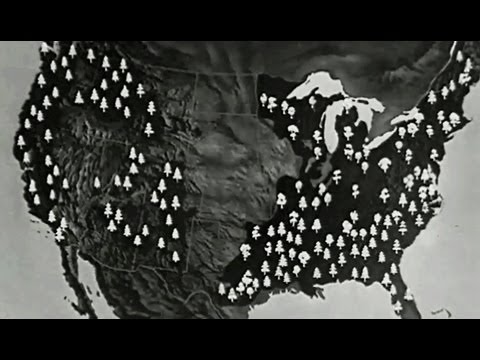more at
NEW VERSION with improved video & sound:
Public domain film from the Prelinger Archive, slightly cropped to remove uneven edges, with the aspect ratio corrected, and mild video noise reduction applied.
The soundtrack was also processed with volume normalization, noise reduction, clipping reduction, and/or equalization (the resulting sound, though not perfect, is far less noisy than the original).
Conservation is an ethic of resource use, allocation, and protection. Its primary focus is upon maintaining the health of the natural world, its fisheries, habitats, and biological diversity. Secondary focus is on materials conservation and energy conservation, which are seen as important to protect the natural world. Those who follow the conservation ethic and, especially, those who advocate or work toward conservation goals are termed conservationists…
Introduction
To conserve habitat in terrestrial ecoregions and stop deforestation is a goal widely shared by many groups with a wide variety of motivations.
To protect sea life from extinction due to overfishing is another commonly stated goal of conservation — ensuring that “some will be available for our children” to continue a way of life.
The consumer conservation ethic is sometimes expressed by the four R’s: ” Rethink, Reduce, Recycle, Repair” This social ethic primarily relates to local purchasing, moral purchasing, the sustained, and efficient use of renewable resources, the moderation of destructive use of finite resources, and the prevention of harm to common resources such as air and water quality, the natural functions of a living earth, and cultural values in a built environment.
The principal value underlying most expressions of the conservation ethic is that the natural world has intrinsic and intangible worth along with utilitarian value — a view carried forward by the scientific conservation movement and some of the older Romantic schools of ecology movement.
More Utilitarian schools of conservation seek a proper valuation of local and global impacts of human activity upon nature in their effect upon human well being, now and to our posterity. How such values are assessed and exchanged among people determines the social, political, and personal restraints and imperatives by which conservation is practiced. This is a view common in the modern environmental movement.
These movements have diverged but they have deep and common roots in the conservation movement.
In the United States of America, the year 1864 saw the publication of two books which laid the foundation for Romantic and Utilitarian conservation traditions in America. The posthumous publication of Henry David Thoreau’s Walden established the grandeur of unspoiled nature as a citadel to nourish the spirit of man. From George Perkins Marsh a very different book, Man and Nature, later subtitled “The Earth as Modified by Human Action”, catalogued his observations of man exhausting and altering the land from which his sustenance derives.
Practice
Distinct trends exist regarding conservation development. While many countries’ efforts to preserve species and their habitats have been government-led, those in the North Western Europe tended to arise out of the middle-class and aristocratic interest in natural history, expressed at the level of the individual and the national, regional or local learned society. Thus countries like Britain, the Netherlands, Germany, etc. had what we would today term NGOs — in the shape of the RSPB, National Trust and County Naturalists’ Trusts (dating back to 1889, 1895 and 1912 respectively) Natuurmonumenten, Provincial conservation Trusts for each Dutch province, Vogelbescherming, etc. — a long time before there were National Parks and National Nature Reserves. This in part reflects the absence of wilderness areas in heavily cultivated Europe, as well as a longstanding interest in laissez-faire government in some countries, like the UK, leaving it as no coincidence that John Muir, the British-born founder of the National Park movement (and hence of government-sponsored conservation) did his sterling work in the USA, where he was the motor force behind the establishment of such NPs as Yosemite and Yellowstone. Nowadays, officially more than 10 percent of the world is legally protected in some way or the other, and in practice private fundraising is insufficient to pay for the effective management of so much land with protective status.

